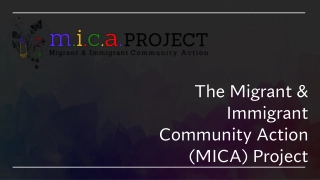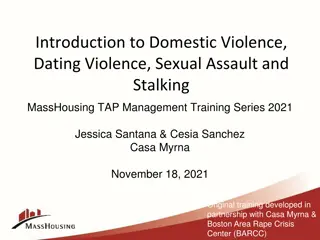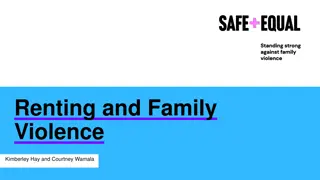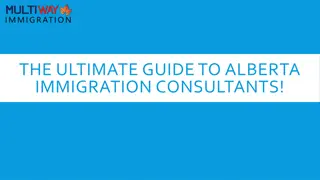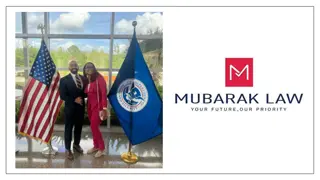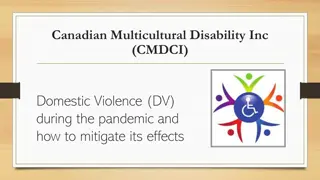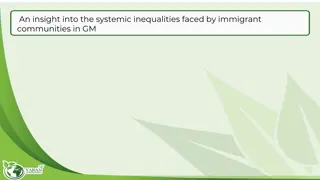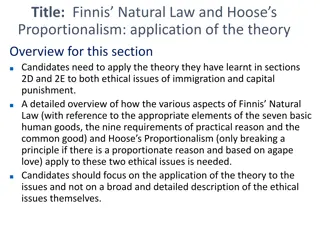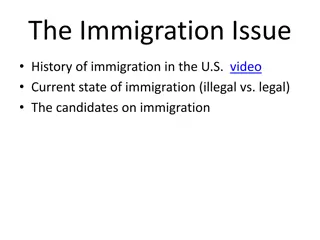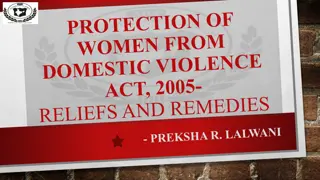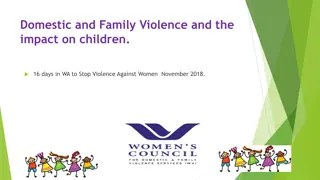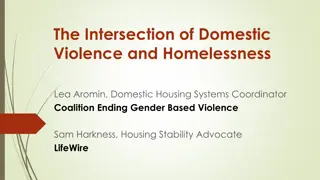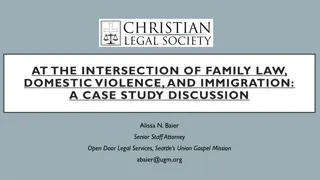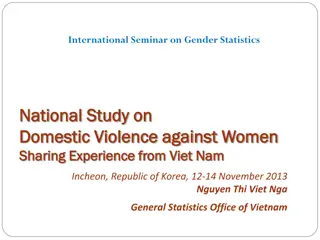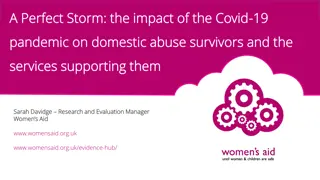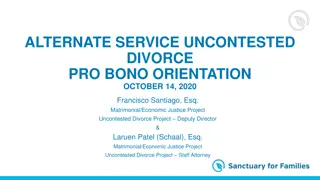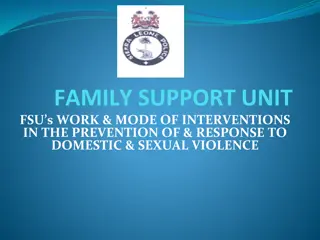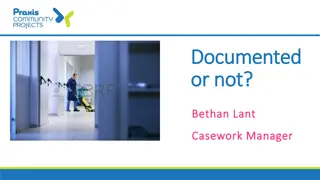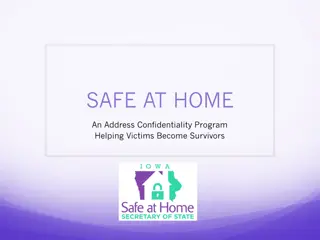Challenges Faced by Immigrant Survivors of Domestic Violence in Accessing Legal Immigration Status
Immigrant survivors of domestic violence encounter numerous barriers in accessing lawful immigration status. This presentation covers key aspects such as the Violence Against Women Act (VAWA), U-visa eligibility, available resources, basic immigration facts, pathways to legal permanent residence, stats on domestic violence and immigrants, and barriers like linguistic challenges and fear of deportation.
Download Presentation

Please find below an Image/Link to download the presentation.
The content on the website is provided AS IS for your information and personal use only. It may not be sold, licensed, or shared on other websites without obtaining consent from the author.If you encounter any issues during the download, it is possible that the publisher has removed the file from their server.
You are allowed to download the files provided on this website for personal or commercial use, subject to the condition that they are used lawfully. All files are the property of their respective owners.
The content on the website is provided AS IS for your information and personal use only. It may not be sold, licensed, or shared on other websites without obtaining consent from the author.
E N D
Presentation Transcript
IMMIGRANT SURVIVORS OF DOMESTIC VIOLENC BARRIERS TO ACCESS AND PATHWAYS TO LAWFUL IMMIGRATION STATUS
BRIEF IMMIGRATION PRIMER ALPHABET SOUP OF FEDERAL AGENCIES AND IMMIGRANT VS. NONIMMIGRANT STATUS FRAMING THE PROBLEM: BARRIERS TO ACCESS FOR UNDOCUMENTED SURVIVORS OF DV LIVING IN THE UNITED STATES PRESENTATION OVERVIEW VIOLENCE AGAINST WOMEN ACT ("VAWA") - CRITERIA AND BENEFITS AVAILABLE U-VISA AKA VICTIM VISA WHO QUALIFIES AND UNDER WHAT CIRCUMSTANCES? LOCAL AND NATIONAL RESOURCES FOR IMMIGRANT SURVIVORS OF DOMESTIC VIOLENCE
BASIC IMMIGRATION FACTS BASIC IMMIGRATION FACTS Non-immigrants Immigrants Temporary stays About 80 different non- immigrant visas About 30 million a year (equal to 10% of US population) Lawful Permanent Residents (LPR)(green card) New arrivals: about 400,000 a year Adjustment of status: 600,000-700,000 a year
HOW DO YOU OBTAIN LEGAL HOW DO YOU OBTAIN LEGAL PERMANENT RESIDENCE? PERMANENT RESIDENCE? Employment- based immigration: 22% Family-based immigration: 58% Refugees and Asylees: 13% Diversity Lottery: 5% Other: 2%
FRAMING THE DISCUSSION: SELECT STATS ON DOMESTIC VIOLENCE & IMMIGRANTS Abuse rates among immigrant women are as high as 49.8%, - almost 3x the national average. At least 41% of surveyed Latinx undocumented survivors of DV don t seek help because they fear that their undocumented status will be exploited in the legal process. 14% of participants reported experiencing problems in accessing DV services due to immigration issues, some reported they were denied services for lack of proper identification. 65% of immigrant victims report some form of immigration related abuse. Among abusive spouses who could have filed legal immigration papers for victims, 72.3% never file immigration papers and the 27.7% who did file had an average delay of 3.97 years. * Source: National Organization for Women (NOW) (available at https://now.org/wp- content/uploads/2017/06/Learn-More-IPV-and-Immigrant-Womenpdf.pdf)
LINGUISTIC BARRIERS BARRIERS TO ACCESS FOR IMMIGRANT SURVIVORS OF DOMESTIC VIOLENCE LACK OF FAMILIARITY WITH THE LEGAL SYSTEM PERVASIVE NARRATIVE RE: INTERAGENCY COOPERATION TOWARDS DEPORTATION PERCEPTIONS OF LAW ENFORCEMENT CULTURAL NORMS FEAR OF INTERPERSONAL RETRIBUTION
WHY ARE SPECIAL IMMIGRATION BENEFITS AVAILABLE WHY ARE SPECIAL IMMIGRATION BENEFITS AVAILABLE TO SURVIVORS OF DOMESTIC VIOLENCE? TO SURVIVORS OF DOMESTIC VIOLENCE? Legislative Intent - we want to incentivize crime reporting, strengthen relationships with law enforcement, and improve community policing which benefits everyone Targeted Victims - Offenders often prey upon the most vulnerable sectors of a population, including immigrants Goal in Common - We all want dangerous/violent offenders drawn to our attention, reported, and ultimately punished (if guilty)
DEFINITION OF DOMESTIC VIOLENCE DEFINITION OF DOMESTIC VIOLENCE IN KENTUCKY IN KENTUCKY family members or members of an unmarried couple: Kentucky law defines domestic violence and abuse as the occurrence of one or more of the following acts between family members or members of an unmarried couple: - physical injury or serious physical injury; - sexual abuse; - assault; - stalking; - strangulation, - putting someone in fear of immediate physical injury, serious physical injury, sexual abuse, strangulation, or assault. family members or members of an unmarried couple: KRS 403.720(1), (7)
TYPES OF PROTECTIVE ORDERS IN TYPES OF PROTECTIVE ORDERS IN KENTUCKY KENTUCKY An emergency protective order (EPO) can be issued without prior notice to the abuser (ex parte) if the judge believes there is an immediate and present danger of domestic violence and abuse.Generally an EPO lasts for 14 days until your hearing for a domestic violence order. A domestic violence order (DVO) can only be issued after you have had a full court hearing where you and the abuser have the opportunity to tell your sides of the story to a judge. If the judge believes that domestic violence or abuse has occurred and may happen again, s/he can issue a DVO. A DVO can last for up to three (3) years.
VIOLENCE AGAINST WOMEN ACT VIOLENCE AGAINST WOMEN ACT ( VAWA ) BACKGROUND ( VAWA ) BACKGROUND The Violence Against Women Act (VAWA) created special routes to immigration status for immigrant survivors of domestic violence who are married to U.S. citizens or Legal Permanent Residents (LPRs) who would otherwise be in a position to file (or withhold filing) for immigration status. Self-petitioning with USCIS: survivors of abuse in this situation are given the opportunity to obtain legal status without the participation or control of the abuser through a VAWA self- petition (Form I-360) with USCIS If a survivor of DV is in removal (deportation) proceedings before the Immigration Court, they may apply for VAWA Cancellation of Removal which would terminate the deportation proceedings and ultimately grant them lawful legal permanent resident status
VAWA SELF VAWA SELF- -PETITION (USCIS FORM I PETITION (USCIS FORM I- - 360) REQUIREMENTS 360) REQUIREMENTS You have a qualifying relationship as the spouse, child, or parent of an abusive U.S. citizen or LPR at the time of filing the petition You were subjected to battery or extreme cruelty by your U.S. citizen or lawful permanent resident relative during the qualifying relationship You are residing or have resided in the United States with your abusive U.S. citizen or lawful permanent resident relative; You are a person of demonstrable "good moral character" Extreme Hardship: you must prove that you, your child, or your parent would suffer extreme hardship if you are deported.
VAWA CANCELLATION VAWA CANCELLATION REQUIREMENTS REQUIREMENTS You have a qualifying relationship as the spouse, intending spouse, former spouse, child, or parent of an abusive U.S. citizen or LPR You were subjected to battery or extreme cruelty by your U.S. citizen or lawful permanent resident relative during the qualifying relationship You are residing or have resided with your abusive U.S. citizen or lawful permanent resident relative; You are a person of demonstrable "good moral character" You have lived continuously in the United States for 3 years immediately preceding the filing of the application. Extreme Hardship: you must prove that you, your child, or your parent would suffer extreme hardship if you are deported.
VAWA VAWA BATTERY AND EXTREME CRUELTY BATTERY AND EXTREME CRUELTY DEFINED (8 C.F.R. DEFINED (8 C.F.R. 204.2(C)(1)) 204.2(C)(1)) . . . [includes] any forceful detention, which results or threatens to result in physical or mental injury. Psychological or sexual abuse or exploitation, including rape, molestation, incest (if the victim is a minor) or forced prostitution shall be considered acts of violence. Other abusive actions may also be acts of violence under this rule. Acts or threatened acts that, in and of themselves, may not initially appear violent may be part of an overall pattern of violence. It is not possible to cite all perpetrations that could be acts of violence under certain circumstances. The Service does not wish to mislead a potentially qualified self-petitioner by establishing a partial list that may be subject to misinterpretation. This rule, therefore, does not itemize abusive acts other than those few particularly egregious examples mentioned in the definition of the phrase was battered by or was the subject of extreme cruelty. 4
VAWA OUTCOMES VAWA OUTCOMES Once a VAWA petition (Form I-360) is approved, the Applicant may then pursue Legal Permanent Resident (LPR) status and their green card either with USCIS or before the Immigration Court. There is no annual cap on the number of applicants who may be approved for VAWA status and the program is not subject to congressional reauthorization or approval. From 2013 to 2017, the U.S. government processed an average of 6,546 VAWA petitions per year, with an average approval rating of 75%.
U U- -VISA BASICS VISA BASICS The U-visa or "victim visa" is reserved for victims of certain, enumerated crimes designated by Congress, including domestic violence, that occur in the United States and violate U.S. law Statutorily, only 10,000 U-visa applications can be granted in any given fiscal year; in fiscal year 2020, 28,364 applications for U visas (principal) were submitted, exacerbating the ballooning waitlist. U-visa applications *must* include a certification from a designated government official who affirms that the Applicant has assisted LE with the investigation and/or prosecution of the qualifying crime
U U- -VISA SPECIFIC STATS VISA SPECIFIC STATS * 25% of perpetrators actively report the victim (typically to ICE) for deportation/removal * 36% of perpetrators get immigrant victims who called police for help arrested for domestic violence * U visa applicants have over 70% cooperation rates in criminal investigation and prosecutions and have 36% higher future crime reporting rates * Source: Krisztina E. Szabo, et.al., Work Authorization For VAWA Self-Petitioners and U Visa Applicants, NIWAP (Feb. 12, 2021)
U U- -VISA REQUIREMENTS VISA REQUIREMENTS (1) The person is a U-visa victim: -Victim of qualifying criminal activity -Victim possesses information about the crime - Criminal activity occurred in the U.S. or violated U.S. law (2) Victim is helpful: -Victim has been, is being, or is likely to be helpful in detection, investigation, prosecution, conviction, or sentencing (3)Victim suffered harm: - Substantial physical or mental abuse as a direct result of the qualifying criminal activity
HELPFULNESS REQUIREMENT HELPFULNESS REQUIREMENT WHO CAN ACT AS THE CERTIFYING OFFICIAL? ACT AS THE CERTIFYING OFFICIAL? WHO CAN Any agency that has criminal investigative jurisdiction may complete the certification of helpfulness. The types of U.S. agencies that will most commonly certify a U visa petition are local, state, and federal police departments and prosecutors. Even a judge may sign a U visa certification, although many will refuse to do so in order to avoid a showing of bias for the prosecution. Law enforcement agencies are NOT obligated to provide a certification of helpfulness, and willingness to do so can vary considerably between individual agencies. The guidelines state that people who are in a supervisory role and have responsibility for issuing certificates of helpfulness must sign the petition, but allows the agency to designate another certifying official if it chooses to do so.
WHAT QUALIFIES AS SUBSTANTIAL MENTAL AND/OR PHYSICAL ABUSE? It is not enough to merely be victim of a qualifying crime. Applicants must have suffered "substantial" physical injury or mental abuse as a result of the criminal activity. Factors that USCIS uses to make this determination are: the nature of the injury inflicted; the severity of the perpetrator s conduct; the severity of the harm suffered; the duration of the infliction of the harm; and the extent to which there is permanent or serious harm to the appearance, health, or physical or mental soundness of the victim. Applicants should provide a personal statement detailing the physical or mental harm suffered, as well as medical records or statements from treating physicians and psychologists, photographs of physical injuries, and affidavits from social workers to prove the substantial nature of the injury.
TIPS FOR ADVOCATES TIPS FOR ADVOCATES Identify and contact resource centers geared toward immigrant assistance Have a list of interpretative services handy/Identify language needs and access a neutral interpreter Determine safety/contact issues, if any Make a safety plan DO: Connect with immigration attorneys/legal services to see about immigration relief options DON T: Contact ICE or CBP to confirm an individual s immigration status
SELECT NATIONAL RESOURCES National Domestic Violence Hotline 1-800-799-SAFE (1-800-799-7233) www.ndvh.org ASISTA (Advanced Special Immigrant Survivors Technical Assistance) 1-860-758-0733 ASISTAhelp.org questions@asistahelp.org The National Center for Victims of Crime 1-800-FYI-CALL (1-800-394-2255) www.ncvc.org
SELECT LOCAL (KY) RESOURCES KENTUCKY COALITION AGAINST DOMESTIC VIOLENCE (502) 209-5382 INFO@KCADV.ORG THE NEST CENTER FOR WOMEN, CHILDREN, AND FAMILIES (859) 259-1974 thenestlexington.org GREENHOUSE17 1-(800)-544-2022 greenhouse17.org ALLIANCE FOR IMMIGRANT WOMEN (NORTHERN KY/CINCINNATI) 513-361-2146 skostoss@ywcacin.org
Please feel free to contact me with any follow-up questions or comments SHANNON@CHURCHLAW.COM


